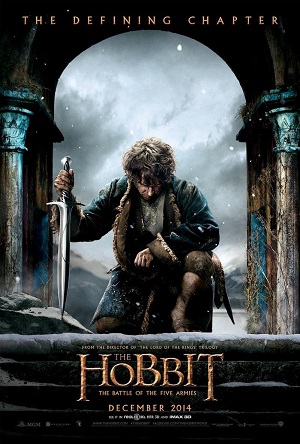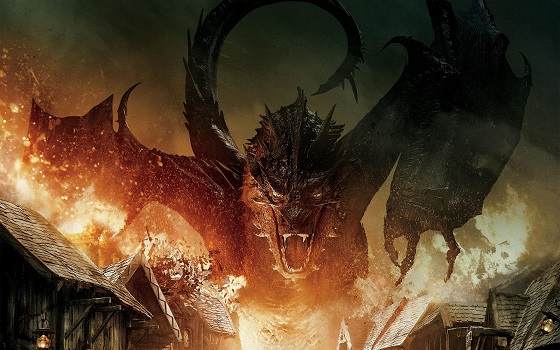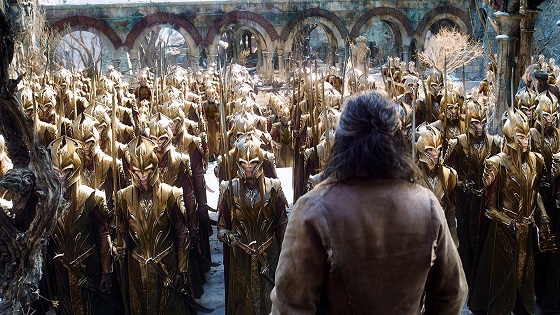“Will you follow me one last time?” Thorin Oakenshield implores his weary party of dwarves (and a very recognizable Hobbit) just before charging into battle against the forces of evil. Director Peter Jackson gives his audience the same plea for the final installment of his blockbuster The Hobbit: The Battle of the Five Armies.
After the premiere of The Battle of the Five Armies, I envision Peter Jackson slumping down into a comfortable armchair with a cup of tea with a Bilbo-esque sigh and stating, “I’ve finally finished my films.” Then he rides his pony to the Grey Havens and departs Middle Earth forever, to be remembered in the songs of Dwarves, Elves, Men, and Hobbits forever. Or something like that.
The Hobbit: The Battle of the Five Armies (herein referred as TBFA for the sake of brevity) picks up where we left the story, with Smaug (voiced by Benedict Cumberbatch) attacking Lake Town, Tauriel (Evangeline Lilly) helping a handful of dwarves and the children of Bard (Luke Evans) to escape, and Bilbo Baggins (Martin Freeman) and company watching the debacle from the slopes of the Lonely Mountain.
Elsewhere, Gandalf (Ian McKellen) is still a prisoner of the Necromancer in Dol Guldur. TBFA begins with the inevitable demise of Smaug, ramping into the problems created by the dragon’s death, notably that the huge treasure of Erebor is now largely unguarded save for Thorin and his compatriots. The people of Lake Town want their share for helping Thorin Oakenshield (Richard Armitage) and in payment for the destruction caused by Smaug.
The Elves want their share. The forces of the Necromancer (Also voiced by Cumberbatch) want Erebor for its strategic position to take back an old kingdom in the north that will aid in the takeover of Middle Earth. As you can guess, all these conflicting and opposing forces have to meet somehow, and Jackson competently handles the ensuing large-scale battle with his usual flair for the fantastical. There’s plenty of plots and subplots winding throughout the film, each reaching its conclusion during the film, and despite its predictability, each resolution feels satisfying in its own way.
As I recall, part of the issue I had with part two was that it was a long movie where not a lot happened. I feel that this could’ve been remedied by taking the first 20 minutes of TBFA and making that the ending of The Desolation of Smaug, and then cutting some of the fluff in the middle, of which there is plenty to choose from. I’m still of the opinion that Tauriel and Legolas (Orlando Bloom) being added to the films was only in the interest of gender diversity and fan service respectively, as neither elf does much to really advance the plot (certainly not both as a unit, pick one, Mr. Jackson), other than getting in an important orc K/O or delivering some random piece of world-building dialogue. Again, while well-acted by Lilly, sadly Tauriel still feels like a tacked-on excuse to have a more emotional/romantic aspect to the story, despite being largely superfluous, though the attempt at gender diversification is welcome.
The fantastical character and world designs of Executive Producer Guillermo Del Toro are again overwhelmingly apparent, and in many cases can come off as a bit more far-fetched than the sole concoctions of Weta Workshop and conceptual artists Alan Lee and John Howe from the original Lord of the Rings trilogy (Not to say he designed them himself, but the fantasy elements are reminiscent of his other films). The grotesque designs of monsters such as the cave trolls (just to give a brief example) often border on the absurd and don’t really hold up to the appearance of functionality over outlandishness — we’re talking cave trolls on double peg-legs here, folks.
Apart from the “magic” aspects of Tolkien’s universe, one thing really I enjoyed about the original Lord of the Rings films was the constant appearance of functionality in all aspects of the production, creature, and character design. But on the other hand, The Hobbit book and film trilogy have always been geared a little more towards the younger audience, so maybe in this case we can excuse the absurdity. I’ll leave that one up to you, dear reader.
I think the biggest plus in this iteration of the series is the subplot involving Gandalf. If you’ve read the novel, he’s the guy who randomly appears and then leaves again. With TBFA, we get the culmination of Gandalf’s absence, involving Elrond (Hugo Weaving), The Lady Galadriel (Cate Blanchett), and Saruman (Christopher Lee), which not only helps the main plotline of Thorin & company, but also gives some phenomenal world-building and tie-ins with Jackson’s previous Lord of the Rings trilogy, especially where the corruption of Saruman is concerned. In fact, I might even argue that the scene involving this subplot near the beginning of the film is one of the best in the Hobbit trilogy in terms of overall vibe, vital importance to the main quest, and general enjoyment. It’s never too long, nor are the ties to the Lord of the Rings trilogy too heavy-handed like they are in much of the rest of TBFA.
Despite some of the heavy handed references to Jackson’s other Middle Earth saga, the bottom line remains that this third and final entry in The Hobbit trilogy is by far the strongest of the three. It gives a faithful and lovingly-crafted foray into Middle Earth for fans of the book and new fans alike, while being able to incorporate lore from other writings of Tolkien into the mix and tying all six films together as a unit, binding them with common story elements and ties to each other. I’ll still maintain that a trilogy was too much for this one tale of Tolkien, and I’m hopeful that there’ll be a cool fan edit of the Hobbit films into a condensed form.








Comments on this entry are closed.